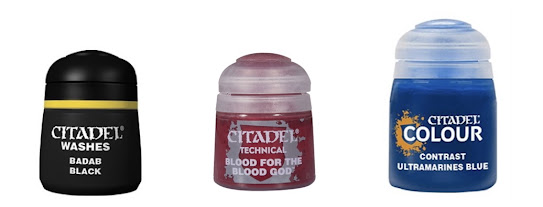Is only Games Workshop innovating miniature paint?
I got into this hobby over 20 years ago. In that time the innovation on the paint side has often seemed stagnant. New paint lines turn up but they’re largely variations on the existing ranges with a similar medium.
Games Workshop has been one of the few companies innovating in the paint space. We’ve seen the washes back in 2007, and technical paints in 2013, where Blood for the Blood God is an especially gruesome success. More recently, in 2019, we saw the release of contrast paints. Love them or hate them they’re innovative. They don’t behave quite like the existing washes and inks and give us new ways to paint models. Following on the heels of contrast paints we got Tesseract Glow, which manages to combine two pigments that behave in different ways to produce extremely easy to achieve weapon glow.
 |
| Left to right: Citadel’s Badab Black wash, Blood for the Blood God, and Ultramarines Blue Contrast paint |
While we’ve seen a little innovation in other brands, like colour shifting paints, these have existed for a long time outside the miniature painting space. Games Workshop is actually coming up with paints that enable new ways to paint our models. Many of these new products are targeted at more casual painters who want to get their army to the table. However many advanced painters are still finding uses for them in specific situations.
Whether you like Games Workshop or not, more tools is always a good thing. Importantly, the innovation is also pushing other paint companies to release competing products, and that’s good for all of us. We’ve seen a number of contrast paint equivalents spring up in the wake of Games Workshop’s initial release.
It’s reasonable to expect Games Workshop to continue to lead the way in paint innovation. Research and development is an expensive investment that may take a lot of money and time to produce valuable results. Being one of, if not the largest player in the miniatures scene, Games Workshop is one of the few companies with the resources to invest in serious R&D.
This pattern is common in other industries. An industry leader does the innovation and releases new products. All their competitors then buy the products, work out what they did, and release their own versions. This is one of the reasons GW’s paints are as expensive as they are, because there is some real R&D being done behind the scenes and that costs money the other paint companies aren’t spending, at least not at the same level.
I’m looking forward to seeing what painting innovations happen in the future. While some of my painting is careful and meticulous, sometimes I just want an army painted so it looks OK on the table. Much of GW’s innovations seems targeted at this latter case, maybe because it also helps new hobbyists feel good. Even if it’s not the best paint job in the world, looking at a table full of painted models is orders of magnitude more satisfying then grey or primer-only plastic.
Now, if only GW would innovate away from those godawful flip top pots... we’re allowed to dream right?



Comments
Post a Comment